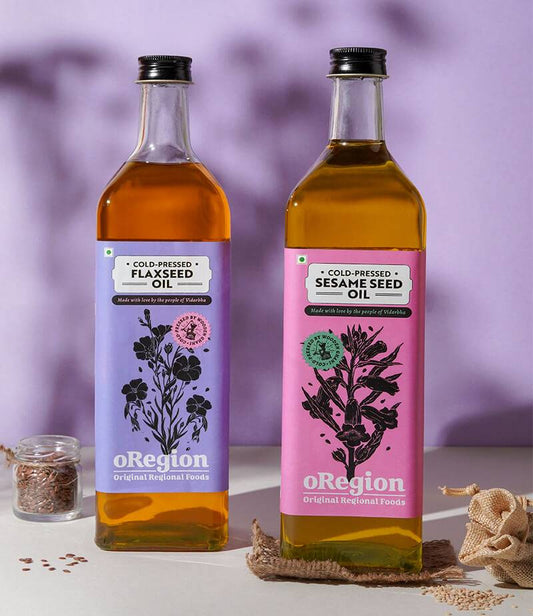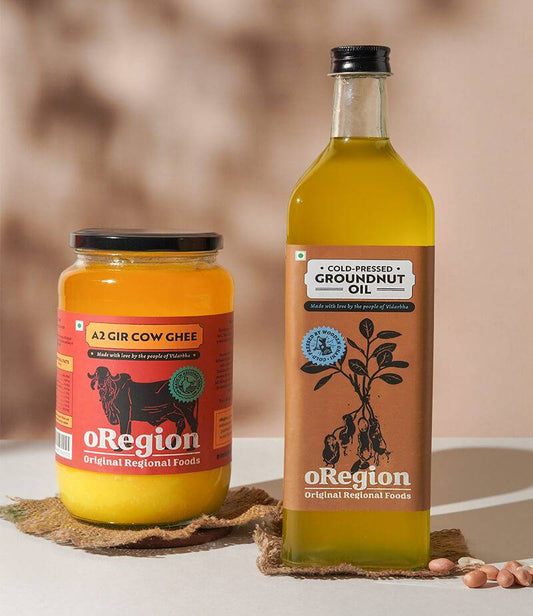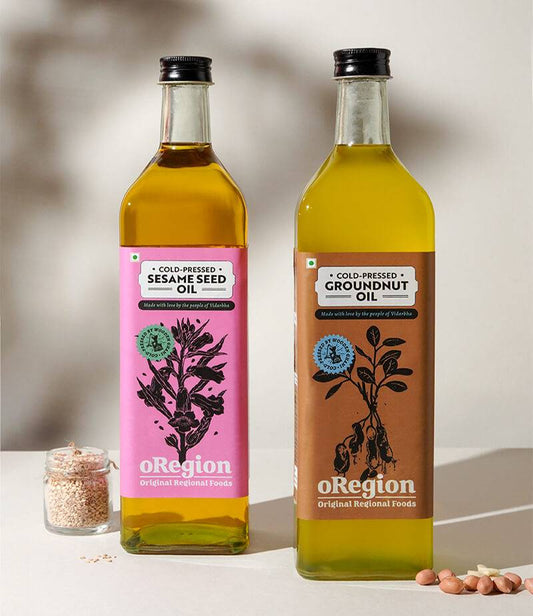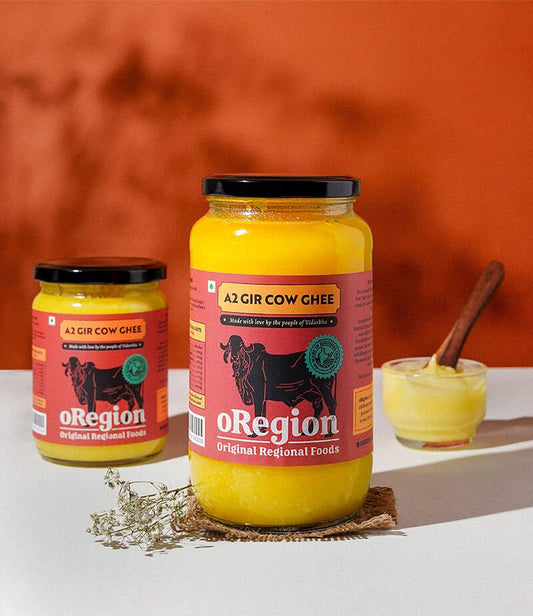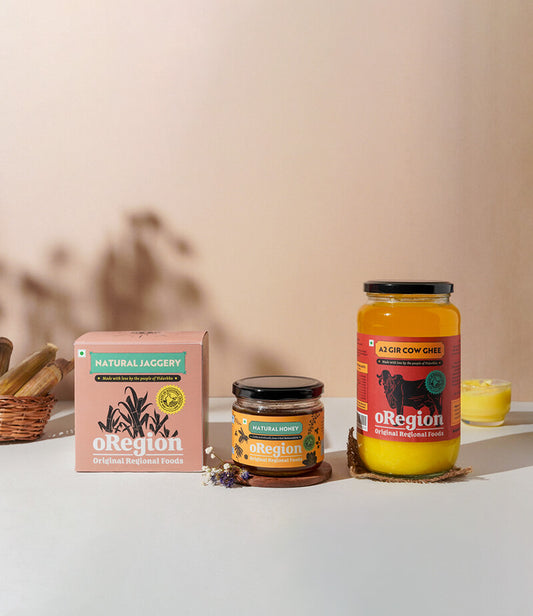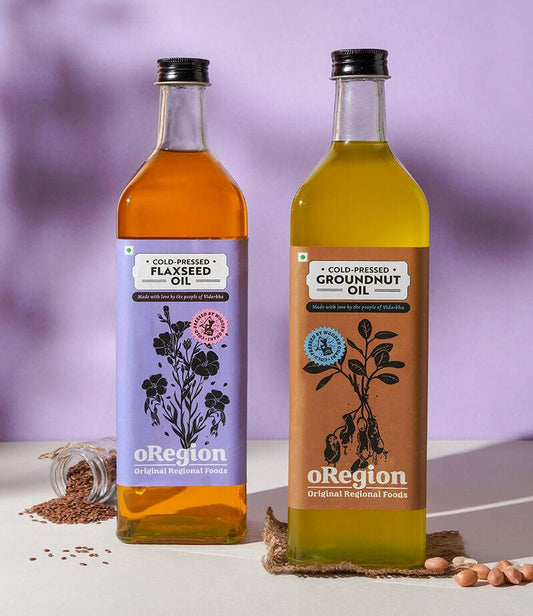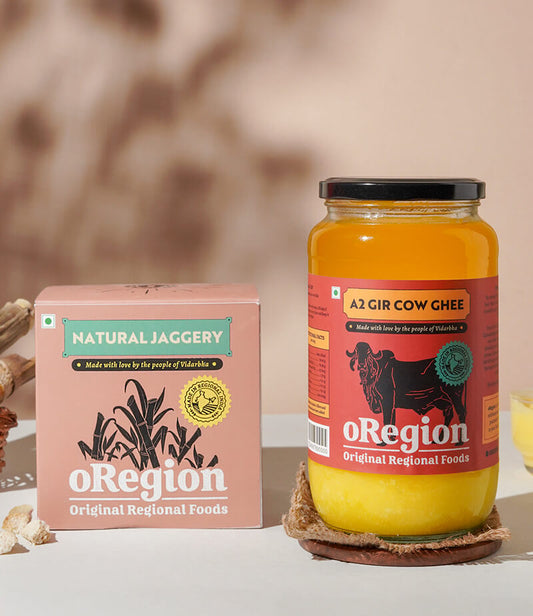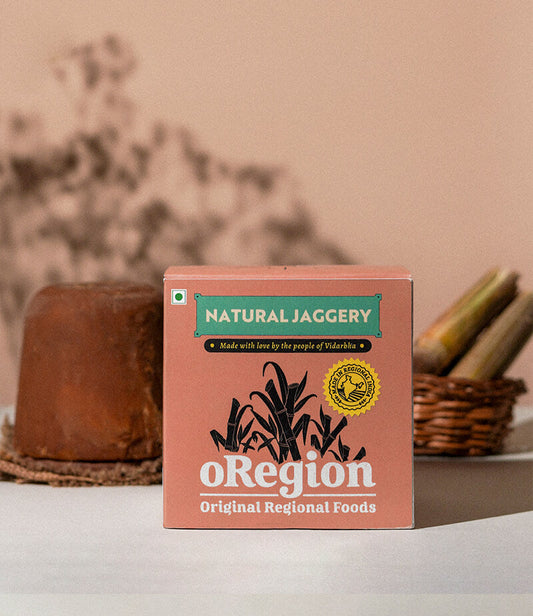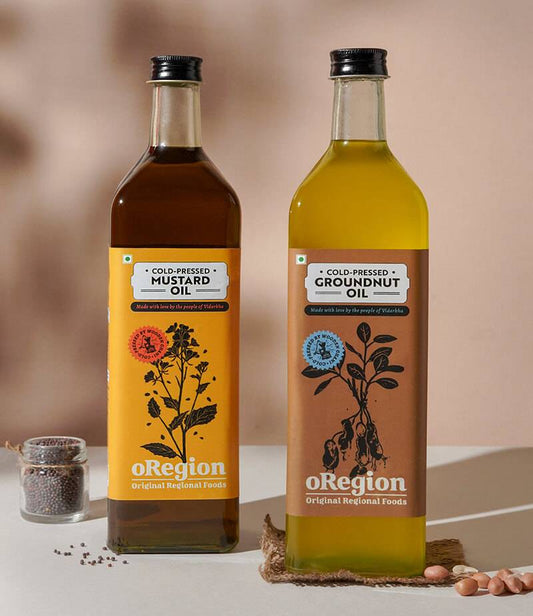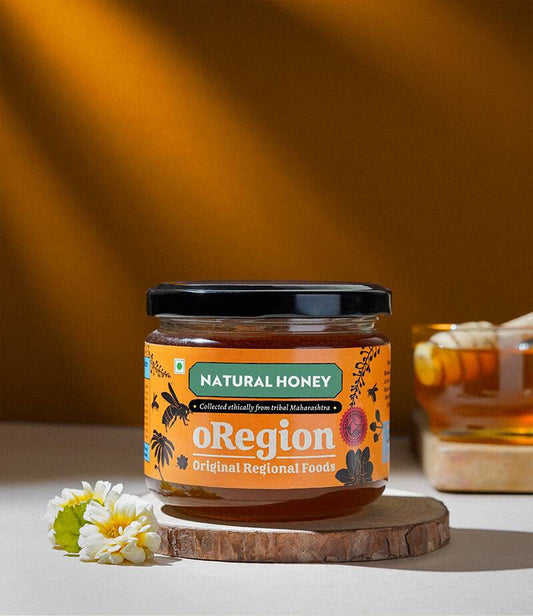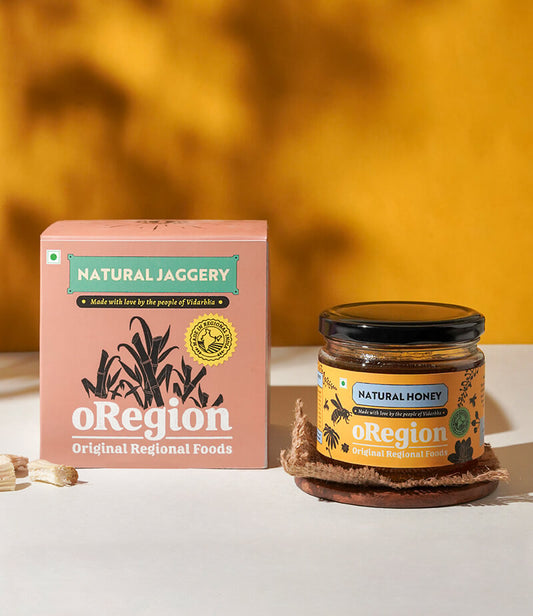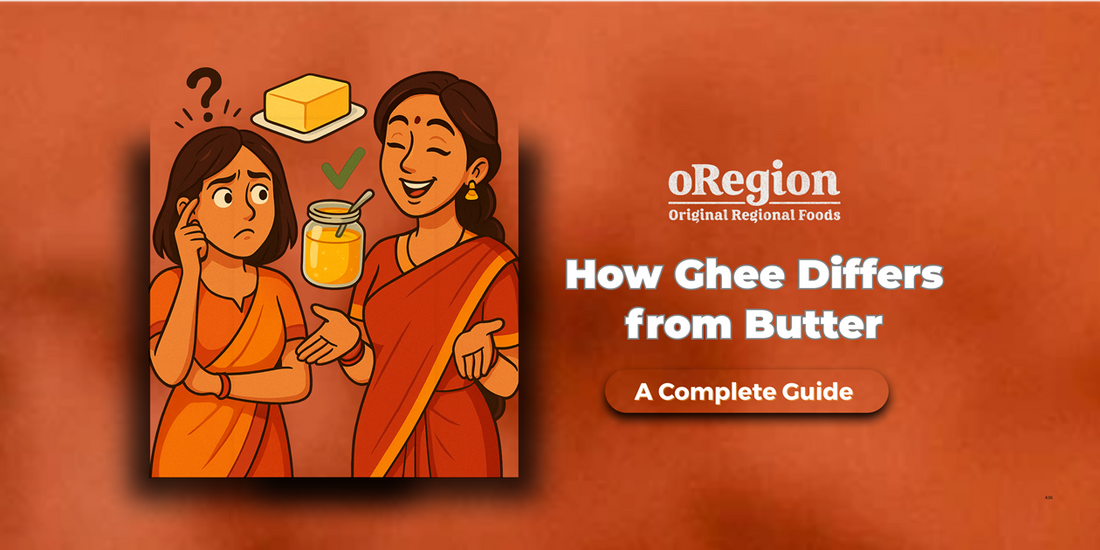
How Ghee Differs from Butter – A Complete Guide
By oregion foodsHow Ghee Differs from Butter – A Complete Guide
Introduction – Why Compare Ghee and Butter?
Ghee and butter are two beloved fats used in kitchens worldwide. While butter has been a Western staple for centuries, ghee holds a sacred place in Indian traditions and Ayurveda. Both offer unique flavors, health properties, and cooking benefits, but they are not the same. With the rise of organic ghee, A2 Gir Cow Ghee, and Bilona Ghee, it is essential to understand how ghee truly differs from butter and why health-conscious individuals often choose ghee over butter.
The Ancient Origins of Ghee in South Asia
Ghee originated in the Indus Valley around 8,000 years ago, when people discovered that clarified butter lasted longer in hot climates. It quickly became central to Indian cuisine, rituals, and Ayurveda. From bilona ghee, churned using traditional methods, to A2 ghee from indigenous cows, ghee remains deeply tied to culture and wellness.
Butter as a Western Staple – A Quick Background
Butter, on the other hand, has been the heart of European kitchens. Its creamy, rich taste makes it ideal for bread, sauces, and baking. But unlike ghee, butter spoils quickly without refrigeration and contains lactose and casein, which can cause digestive issues.
Why This Comparison Matters for Today’s Kitchen
As more people look for natural fats that support digestion, immunity, and energy, the choice between butter and ghee becomes more than just taste—it becomes a lifestyle decision.
What Exactly Is Butter?
Composition and Nutritional Profile of Butter
Butter is made from cream and contains 80% fat, along with water, lactose, and milk proteins. It’s rich in vitamins A, D, E, and K, but also contains saturated fat and cholesterol.
How Butter Is Traditionally Made
Traditionally, butter is churned from cream until the fat separates from the buttermilk. Today, it is mass-produced and often salted or flavored.
Does Butter Go Bad? Shelf Life and Storage Tips
Butter must be refrigerated, and even then, it has a short shelf life of a few weeks. Exposure to heat or light causes it to become rancid.
What Is Ghee?
The History of Ghee – From Indus Valley to Modern Kitchens
Unlike butter, ghee is clarified butter, simmered until milk solids separate. This process leaves behind a golden, aromatic fat that can last months without refrigeration.
Ghee vs. French Clarified Butter – What Makes It Unique
Though similar, ghee is cooked longer than clarified butter, giving it a nutty, caramel-like flavor and higher smoke point.
Nutritional Value of Ghee – Calories, Fat, and Benefits
Ghee is nearly pure fat with no lactose or casein. It contains butyric acid, omega-3 fatty acids, and fat-soluble vitamins, making it easier to digest and healthier for most people than butter.
Why Betel Leaf Ghee Is Special – Traditional Ayurvedic Wisdom
In Ayurveda, adding betel leaf to ghee enhances its digestive, detoxifying, and anti-inflammatory properties, making it a unique wellness food.
Taste and Aroma – Ghee vs. Butter
Flavor Profile of Butter – Creamy and Rich
Butter offers a creamy, slightly salty taste that enhances bread, sauces, and baked goods.
Flavor Profile of Ghee – Nutty, Caramel-Like, and Aromatic
Ghee has a toasty, rich flavor that makes curries, sweets, and even coffee deeply satisfying.
How Betel Leaf Enhances the Taste of Ghee Naturally
Adding betel leaf gives ghee a refreshing, mildly spicy aroma, elevating its culinary and medicinal value.
Health Benefits – Ghee Compared with Butter
Lactose and Casein Content – Why Ghee Is Easier to Digest
Since the milk solids are removed, ghee is lactose-free, making it suitable for lactose-intolerant individuals.
Omega-3 Fatty Acids and Healthy Fats in Ghee
A2 Gir Cow Ghee and bilona ghee are rich in omega-3 fatty acids, which support brain and heart health.
Betel Leaf in Ghee – Digestive, Anti-Inflammatory, and Detoxifying Properties
Betel leaf enhances gut health, reduces inflammation, and aids natural detoxification.
Ghee for Heart, Immunity, and Energy Levels
Ghee strengthens immunity, supports heart function, and provides long-lasting energy.
Butter’s Health Profile – The Good and the Cautions
While butter contains similar vitamins, it may raise cholesterol levels and cause digestive discomfort for some people.
Cooking Differences Between Ghee and Butter
How is Ghee Different from Butter?
Ghee and butter may look similar, but they differ in nutrition, shelf life, and health benefits. Butter contains water, lactose, and milk proteins, making it less suitable for those with lactose intolerance, while ghee is pure fat, free from lactose and casein, and easier to digest. Ghee has a higher smoke point (485°F) than butter (350°F), making it ideal for high-heat cooking. Unlike butter, which spoils quickly, ghee stays fresh for months without refrigeration. With its nutty flavor and Ayurvedic benefits, ghee is a healthier, more versatile choice than butter.
Read More : The Science of Desi Ghee & Betel Leaf Ghee
Smoking Point of Butter vs. Ghee
Butter burns at 350°F (175°C), while ghee has a high smoke point of 485°F (250°C), making it ideal for frying and deep cooking.
Shelf Life and Storage – Pantry-Friendly Ghee vs. Refrigerated Butter
Ghee stays fresh for months without refrigeration, unlike butter.
Everyday Cooking Uses – From Frying to Baking
Butter shines in baking, while ghee is excellent for frying, sautéing, and everyday cooking.
Traditional Indian Cooking – Tadka, Roti, and Sweets with Ghee
From dal tadka to rotis brushed with ghee, Indian households rely on it for flavor and health.
Modern Uses – Stir-Fry, Baking, and Coffee with Ghee
Today, health-conscious people add ghee to bulletproof coffee and even use it in keto diets.
Read More : A1 vs A2 Cow Ghee: Key Differences & Benefits
Making Ghee at Home
Step-by-Step Process of Making Ghee
-
Heat unsalted butter slowly.
-
Let the water evaporate and solids settle.
-
Strain the golden liquid fat.
Signs of Perfectly Prepared Ghee
A nutty aroma, golden color, and grainy texture show ghee is ready.
Adding Betel Leaf for Medicinal and Flavor Benefits
Adding betel leaf during preparation enhances ghee’s healing properties.
How to Store Homemade Ghee Safely
Keep ghee in a glass jar, away from sunlight, for a long shelf life.
Buying Ghee – What You Need to Know
Best Places to Buy Authentic Ghee
Choose trusted brands like oRegion for organic, A2 Gir Cow Ghee.
How to Identify Pure Ghee vs. Adulterated Products
Pure ghee solidifies in winter, melts in summer, and has a rich aroma.
Why oRegion Gir Cow Ghee with Betel Leaf Is Different
oRegion ensures authentic A2 Bilona Ghee, prepared traditionally, infused with betel leaf for added health benefits.
Ghee in Ayurveda and Traditional Healing
Ghee as a Healing Food in Ayurveda
Ghee is considered ojas (life energy), boosting vitality and longevity.
Betel Leaf and Ghee – A Combination Rooted in Tradition
This pairing supports digestion, improves metabolism, and enhances immunity.
Ghee in Rituals, Fasting, and Indian Households
From Diwali diyas to fasting meals, ghee is deeply woven into Indian culture.
Can You Substitute Ghee and Butter?
When to Use Butter Instead of Ghee
Butter works best in baking recipes requiring moisture.
Best Substitutes for High-Heat Cooking vs. Baking
For frying, ghee is unmatched; for baking, butter or coconut oil are better.
Frequently Asked Questions about Ghee and Butter
Is Ghee Healthier Than Butter?
Yes, ghee is healthier due to its digestibility, higher smoke point, and nutritional value.
Can Lactose-Intolerant People Eat Ghee?
Yes, because ghee is free from lactose and casein.
Does Ghee Contain Cholesterol?
Yes, but in moderation, it supports good cholesterol and heart health.
How Long Does Ghee Last Without Refrigeration?
Ghee can last up to a year when stored properly.
Can I Add Betel Leaf to Store-Bought Ghee?
Yes, warming ghee with betel leaf enhances its properties.
The Bottom Line – Why Choose Ghee Over Butter?
Quick Comparison – Ghee vs. Butter
-
Lactose-Free:
-
Butter – ❌ Contains lactose
-
Ghee – ✅ Completely lactose-free
-
Shelf Life:
-
Butter – Lasts only a few weeks (needs refrigeration)
-
Ghee – Stays fresh for months without refrigeration
-
Smoke Point:
-
Butter – ~350°F (burns easily)
-
Ghee – ~485°F (ideal for frying and high-heat cooking)
-
Flavor:
-
Butter – Creamy, slightly salty
-
Ghee – Nutty, caramel-like, aromatic
-
Digestibility:
-
Butter – May cause issues for lactose-sensitive people
-
Ghee – Easy to digest and suitable for most diets
The Role of Betel Leaf Ghee for Modern Wellness
oRegion Betel Leaf Gir Cow Ghee is more than food—it’s medicine, combining ancient wisdom with modern health needs.
Read More : Why Gir Cow Ghee is Best for Lactose Intolerance
Final Thoughts – Bringing Tradition to Your Table
Choosing pure ghee over butter means embracing tradition, taste, and health. Whether you opt for A2 Gir Cow Ghee, bilona ghee, or organic ghee, you’re not just choosing a cooking fat—you’re choosing wellness.
Follow us for more wellness tips
📸 Instagram: @oRegion.in
📘 Facebook: facebook.com/oRegion.in
▶ YouTube: https://www.youtube.com/@oRegion_foods
👉 Buy Now on oregion.in
